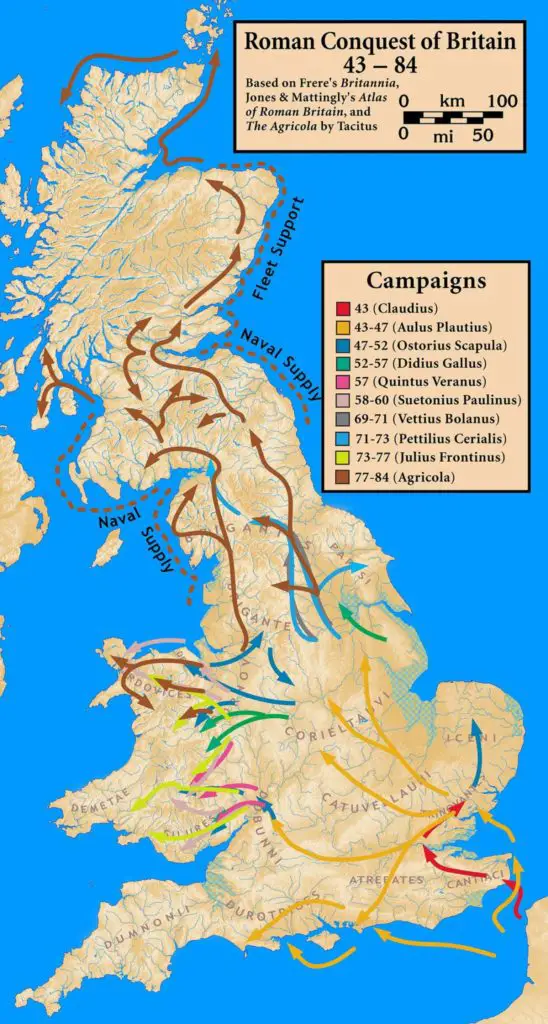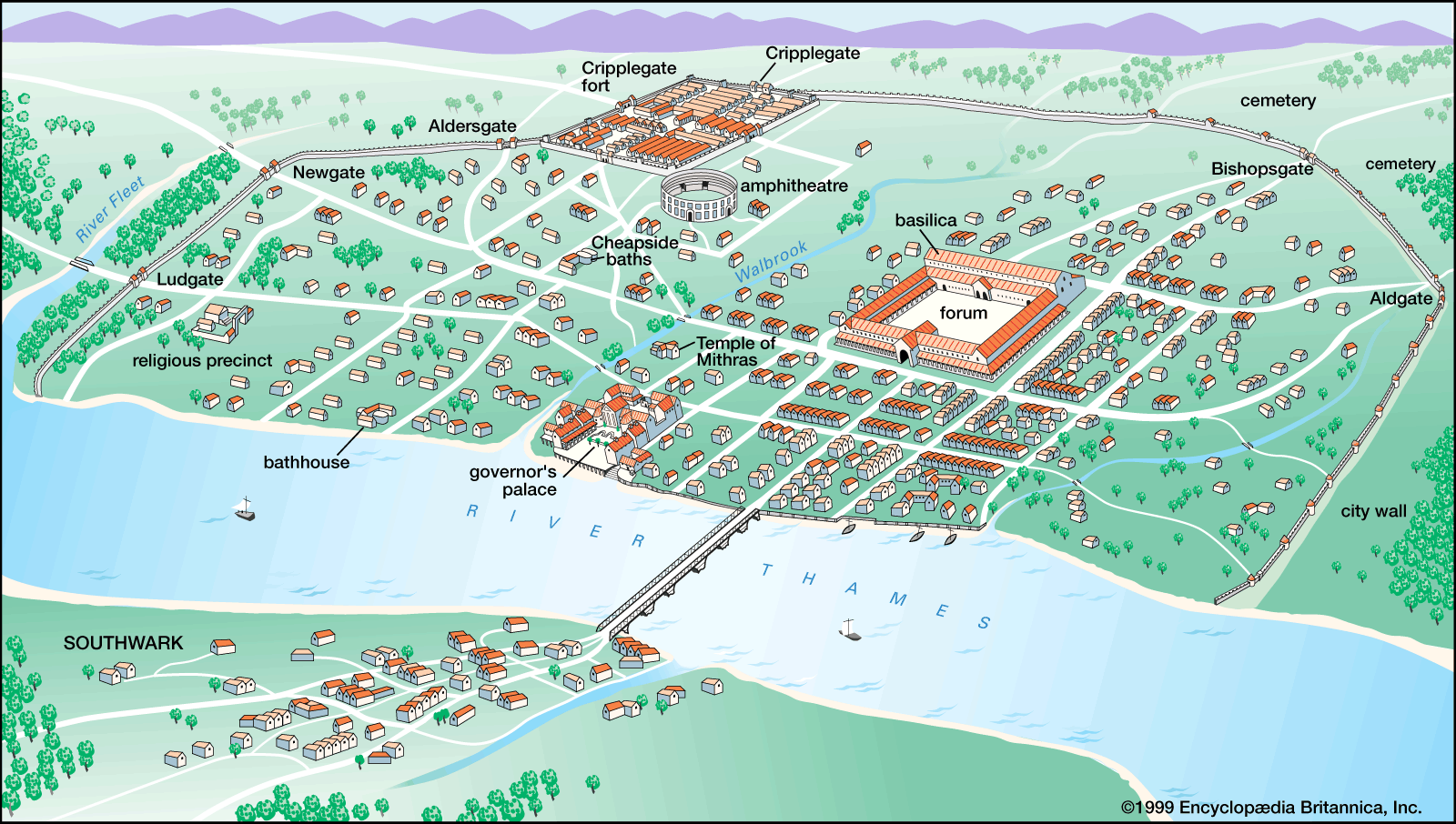The Roman Empire in Britain was one of the most significant periods of the island’s history. It changed the face of the country for hundreds of years. But how did this dramatic change begin?
Troublesome Beginnings
The start of Roman rulership in Britain really begins with Julius Caesar’s incursions into the island in the first century B.C.E. There were two attempts made, with the first ending in disaster for the Romans. They were driven back from the island very soon after landing, being completely unprepared for the foreign and comparatively chaotic fighting style of the Britons.
The following year, 54 B.C.E., the Romans returned under Caesar and made much more progress through the country. The various British tribes of the south east had been fighting amongst themselves, but upon the arrival of the Romans, they united under one ruler. This ruler was Cassivellaunus, the king of the Catuvellauni, one of the most powerful tribes in Britain at that time.
Though Cassivellaunus put up a powerful defense, many tribes sided with Caesar as the fighting went on, and the Roman leader was eventually able to force Cassivellaunus into submission.
Right from the start, one British chief, Mandubracius, was working with Caesar to subdue Cassivellaunus, due to the trouble that he had caused him. After the Romans had defeated this powerful British leader, Caesar compelled Cassivellaunus to no longer cause any trouble for Mandubracius. He also compelled the Britons to send him a yearly tribute.
While Caesar was able to show his might to the Britons and establish a firm connection between the island and the continent for the first time, he did not achieve anything in the way of conquest. Nonetheless, his incursions had resulted in the ‘mysterious’ island of Britain being demystified to the Romans for the first time. Trade links and even friendships were now established.
The True Rise of the Empire
 A little under a century later, the Roman Emperor Caligula made plans to conquer Britain. However, this never actually transpired.
A little under a century later, the Roman Emperor Caligula made plans to conquer Britain. However, this never actually transpired.
Three years later, in 43 C.E., the Emperor of Rome was Claudius. The available sources give conflicting claims for his motivation, but whatever it was, in this year he decided to invade Britain. According to one source, it was because he desired to give himself a glorious victory to bolster his fame and reputation. According to another source, he was motivated by the fact that Verica, the king of the Atrebates tribe in southern Britain, pleaded with Claudius to assist him in reclaiming his throne, which he had recently been expelled from.
It is likely that it was for a combination of reasons, rather than just one, that led to Claudius invading Britain. In any case, the invasion took place. There is some measure of debate over where exactly the invading force landed. It has generally been concluded that they landed in the east of the country, at Richborough, Kent. However, there are a number of scholars who believe that at least some of the invading forces arrived much further west, in the West Sussex or Hampshire area. This latter view ties in well with the information about Verica wanting to be reinstated by the Romans, for he had been a king of that very area.
In any case, the Romans made swift progress very early on. There were two particularly notable battles along rivers at this early stage. The first was the battle on the River Medway, which lasted for two days. Then, as the Romans continued to progress through the country, a battle was fought on the Thames. After this battle, Togodumnus, the chief king of the Britons who was opposing the Romans, was killed.
While the Britons were attempting to avenge the death of their king, the Roman leader, Plautius, called for Emperor Claudius to come to Britain and join the conquest. This he did, and he was able to bring about the surrender of almost a dozen kings without force. Thus, the Roman Empire was able to make extremely effective and remarkably swift progress through the country at this early stage of the invasion.
The expansion of the empire was similarly effective (though perhaps not quite so bloodless) further west. Vespasian headed the Legio II Augusta, which was the legion that had fought against Togodumnus, and attacked the West Country. He captured twenty towns and was said to have subjected two ‘nations’, or tribes, which have been identified by modern scholars as most likely being the Durotriges and the Dumnonii in the south west. In c. 50 C.E., soon after Vespasian left Britain, a Roman legionary fortress was established at Exeter.
The Silures
Meanwhile, Togodumnus’ brother Caratacus was causing serious trouble for the Romans in Wales. The invaders had first attempted to infiltrate that area in 47, when a new governor of Britain had been appointed. This governor was Publius Ostorius Scapula. He was opposed by Caratacus for some time (who, after the defeat of his own tribe, had re-emerged as the chief of the Silures, a tribe in south east Wales). Finally, in the year 50, Caratacus was defeated.
This incident provides a valuable insight into the fact that many of the tribes in Britain at this point, while not exactly under Roman domination, were loyal to Rome. After Caratacus had been defeated at the battle of Caer Caradoc, he fled to Cartimandua, the queen of the Brigantes, a large tribe in the middle of Britain. However, while she was still an independent British queen in her own right, she did not side with her fellow British king. Instead, she handed Caratacus in chains to the Romans.
Nonetheless, despite Caratacus’s defeat and capture, the Romans were still not able to get a firm grasp on the south of Wales. Even after the defeat of their war leader, the Silures continued to put up a ferocious fight against the invaders, so much so that the governor, Ostorius, was reported as saying that the tribe was so dangerous that it would need to either be transported or completely exterminated.
As it happened, the Roman governor died in 52. The Silures continued to cause intense trouble for the Romans, even capturing the soldiers that they defeated and distributing them among themselves and their neighboring tribes as slaves. In the same year in which Ostorius died, it is also reported that they defeated an entire legion, the II Augusta. It was not until eight governors later, in the year 78, that this tribe was finally subjugated.
The Northern Conquests
While the Legio II Augusta travelled west, the Legio IX Hispana was sent north. It did share in the defeat of Caratacus in Wales in the year 50, but it subsequently went to the Lincoln area. They established the legionary base known as Lindum Colonia. Around this time, in the 50s, the husband of Cartimandua revolted. His name was Venutius, and the Romans were able to defeat him, though they did not kill him.
Cartimandua’s tribe, the Brigantes, took up a substantial portion of the centre of Britain, so her alliance with the Romans was of significant benefit to the invaders. The Parisi, a smaller tribe to the east of the Brigantes, were also allied to the Romans. The Coritani, the tribe to the immediate south of the Parisi, receive no prominent mention in the accounts of the Roman conquest of Britain. They certainly do not seem to have offered any serious resistance to the Empire, so they either allied themselves as well or simply allowed themselves to be fully subjugated by Rome.
Beneath the Coritani, predominantly in the Norfolk area, were the Iceni. They, too, allied themselves with Rome. From this we can see that an incredibly substantial part of the middle of Britain accepted loyalty to Rome without any resistance. The expansion of the Empire into Britain thus proved to be, on the whole, a swift and bloodless affair for much of the southern half of Britain.
Boudicca’s Rebellion
 However, things were about to change. The following incident illustrates the fine line between having a ‘friendly’ allied kingdom and actually trying to dominate that kingdom. The Iceni remained pro-Roman until the death of its king, Prasutagus, in the year 60. After his death, the Romans attempted to completely take over control of the kingdom, leading directly to the famous and incredibly bloody rebellion of Boudicca.
However, things were about to change. The following incident illustrates the fine line between having a ‘friendly’ allied kingdom and actually trying to dominate that kingdom. The Iceni remained pro-Roman until the death of its king, Prasutagus, in the year 60. After his death, the Romans attempted to completely take over control of the kingdom, leading directly to the famous and incredibly bloody rebellion of Boudicca.
Both the Iceni and the Trinovantes took part in this rebellion, first attacking Camulodunum, completely destroying it. The IX Hispana attempted to quash the attacks, but was itself defeated by Boudicca’s troops. The rebels moved on to Londinium and Veralum, both of which were completely destroyed. However, a force led by Suetonius the governor of Britain managed to defeat Boudicca and her far more numerous forces in open battle, resulting in the death of the rebels’ leader.
The intense and vicious rebellion had almost led to the abandonment of Britain by Emperor Nero, but now, by the year 61, the Romans had the province back under their control.
Client Kingdoms Are Conquered
Venutius, the former husband of Cartimandua mentioned earlier, rebelled for a second time in the year 69. It seems that his attacks were directly primarily against his ex-wife rather than the Romans themselves, at least at first. Cartimandua called on the Romans for help, but they did not send many reinforcements. She was evacuated from her kingdom, and Venutius took power.
The Romans were subsequently able to defeat Venutius, and eventually the entire Brigantes tribe was conquered. However, this appears to have been a slow and painful process, lasting until near the end of the first century. Thus, it appears that when the Romans were actively opposed by the natives, at times it was incredibly difficult to progress through the territory.
The Parisi, too, came to be dominated by the Empire around this era. Incidentally, this also corresponds to the general time frame in which the Silures in south east Wales were subjected.
In the late 70s, Agricola started to campaign across Britain to consolidate Roman control over various tribes. Some had started to re-establish their independence, such as the inhabitants of north Wales. These were effectively dealt with, and progress through to the north of the country really began to start with this campaign. By the beginning of the 80s, the Romans were actually campaigning in Scotland itself.
During this campaign of Agricola’s, quite a number of forts were set up, establishing definite Roman control over the region. They had engulfed all of southern Scotland and captured much of the eastern side up until nearly the northern-most part. However, Agricola was recalled soon after, and within a number of years, Roman domination over most of Scotland began to disintegrate.
Thus, by the end of the first century, the Roman Empire had control of the entire island of Britain from the southern coast up to more or less the present-day border between England and Scotland. While the extent of the Roman Empire in the island would expand and contract slightly at various points over the following 300 years, the Romans had now gained control of the territory that would, on the whole, make up ‘Roman Britain’ for the rest of the length of its existence.

